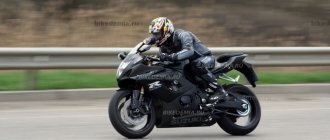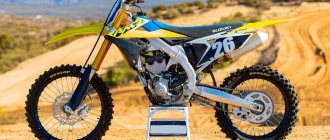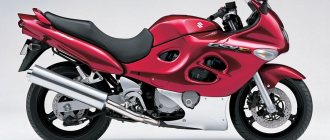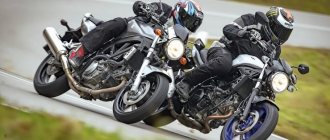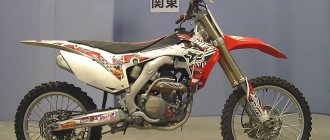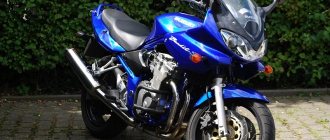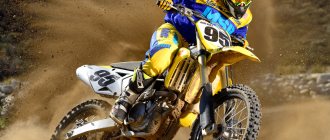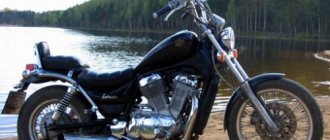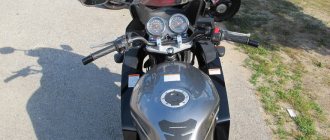| Suzuki GSX-R1000 K1-K2 (2001-2002) | Suzuki GSX-R1000 K3-K4 (2003-2004) | Suzuki GSX-R1000 K5-K6 (2005-2006) | Suzuki GSX-R1000 K7-K8 (2007-2008) |
| Suzuki GSX-R1000 K9-L1 (2009-2011) | Suzuki GSX-R1000 L2-L6 (2012-2016) | Suzuki GSX-R1000 L7+ (2017+) |
Suzuki GSX-R 1000 sports motorcycle model
was first introduced in 2001. At that time, the motorcycle was based on the Suzuki GSX-R 750, the engine of which was slightly larger in volume, and the frame was 0.5 mm thicker (which, according to Suzuki, increased rigidity by 10%).
In 2002, the model changed slightly, receiving updates to the fuel pump, clutch, front axle and injector (automatic idle appeared).
In 2003, the Suzuki GSX-R1000 model was seriously updated. The frame gets reinforcements, the overall height and seat height are reduced, new 4-piston radial calipers instead of the usual 6-piston ones, lightweight wheels, a new 32-bit control unit, and an LED brake light. Models of this generation are distinguished by a black frame, wheels and fork finish, and an all-titanium exhaust system. Minor changes to the engine (maximum power increases slightly).
In 2005, the model undergoes another restyling. The model receives a new engine (power increases to 178 hp), a new exhaust system, increased size of brake discs and new Tokico calipers, a reduction in the wheelbase and overall length of the motorcycle.
2007 is the third major update of the Suzuki GSX-R1000 model. Updated environmental regulations forced Suzuki to change the exhaust system, which led to an increase in the weight of the motorcycle. To compensate for this, the company has improved the aerodynamics of the bike, installed larger throttle bodies and optimized the engine, increasing maximum power to 185 hp. The model also received the S-DMS (Suzuki Drive Mode Selector) system with the ability to choose from 3 engine operation maps and a hydraulic clutch drive.
In 2009, Suzuki announced another major update to the Suzuki GSX-R1000. The model received a new frame and engine, a new Showa Big Piston Fork (BPF), and new Tokico monoblock front calipers. Models of this generation are distinguished by a double muffler.
The next model update occurred in 2012. The Suzuki GSX-R 1000 model received an update to the engine (increased compression ratio, changed camshaft cams, steel exhaust valves, improved crankcase ventilation and reduced losses from the oil pump, upgraded exhaust system internals) and brake system (new Brembo calipers, new brake discs made of heat-resistant stainless steel, reducing the total weight by 130 grams).
In 2015, modifications with ABS appeared.
In 2021, the Suzuki GSX-R1000 model is again being restyled. In addition to versions with ABS, an R-modification appears - Suzuki GSX-R1000R
. It is distinguished by the presence of a quickshifter (up and down), launch control and the Motion Track Brake System. The updated Suzuki GSX-R1000 model receives an SR-VVT system that changes the engine compression ratio depending on the speed; 10-level traction control controlled by IMU; new braking system (brake discs enlarged to 320 mm, new generation of Brembo monoblock calipers); new Shows BFF front suspension and BFRC Lite rear shock. The engine reduces its stroke, and maximum power increases to 201 hp.
Suzuki GSX-R1000: electronic options
- Motion Track Traction Control System - from 2021
- Quick shifter (dual) - from 2021
- Motion Track Brake System - from 2021
- Launch control - from 2021, GSX-R1000R
- Suzuki Drive Mode Selector
- Low RPM Assist
- Suzuki Easy Start System
The main competitors of the Suzuki GSX-R 1000 in the class:
- Honda CBR1000RR Fireblade
- Kawasaski ZX-10R
- Yamaha YZF-R1
Brief history of the model
- 2001 - start of production and sales. First generation
.
Model
: Suzuki GSX-R1000 (Europe, North America, Australia).
Factory designation
: GSX-R1000K1.
- 2002 - no significant changes.
Model
: Suzuki GSX-R1000 (Europe, North America, Australia).
Factory designation
: GSX-R1000K2.
- 2003 - restyling of the model. Second generation
.
Model
: Suzuki GSX-R1000 (Europe, North America, Australia).
Factory designation
: GSX-R1000K3.
- 2004 - no significant changes.
Model
: Suzuki GSX-R1000 (Europe, North America, Australia).
Factory designation
: GSX-R1000K4.
- 2005 - restyling of the model. Third generation
.
Model
: Suzuki GSX-R1000 (Europe, North America, Australia).
Factory designation
: GSX-R1000K5.
- 2006 - no significant changes.
Model
: Suzuki GSX-R1000 (Europe, North America, Australia).
Factory designation
: GSX-R1000K6.
- 2007 - restyling of the model. Fourth generation
.
Model
: Suzuki GSX-R1000 (Europe, North America, Australia).
Factory designation
: GSX-R1000K7.
- 2008 - no significant changes.
Model
: Suzuki GSX-R1000 (Europe, North America, Australia).
Factory designation
: GSX-R1000K8.
- 2009 - restyling of the model. Fifth generation
.
Model
: Suzuki GSX-R1000 (Europe, North America, Australia, Asia).
Factory designation
: GSX-R1000K9.
- 2010 - no significant changes.
Model
: Suzuki GSX-R1000 (Europe, North America, Australia, Asia).
Factory designation
: GSX-R1000L0.
- 2011 - no significant changes.
Model
: Suzuki GSX-R1000 (Europe, North America, Australia, Asia).
Factory designation
: GSX-R1000L1.
- 2012 - restyling of the model. Sixth generation
.
Model
: Suzuki GSX-R1000 (Europe, North America, Australia, Asia).
Factory designation
: GSX-R1000L2.
- 2013 - no significant changes.
Model
: Suzuki GSX-R1000 (Europe, North America, Australia, Asia).
Factory designation
: GSX-R1000L3.
- 2014 - no significant changes.
Model
: Suzuki GSX-R1000 (Europe, North America, Australia, Asia).
Factory designation
: GSX-R1000L4.
- 2015 - appearance of versions with ABS.
Model
: Suzuki GSX-R1000 + ABS (Europe, North America, Australia, Asia).
Factory designation
: GSX-R1000L5 + GSX-R1000AL5.
- 2016 - no significant changes.
Model
: Suzuki GSX-R1000 + ABS (Europe, North America, Australia, Asia).
Factory designation
: GSX-R1000L6 + GSX-R1000AL6.
- 2017 - restyling of the model. Seventh generation
.
Model
: Suzuki GSX-R1000 + ABS;
Suzuki GSX-R1000R + ABS (Europe, North America, Australia, Asia). Factory designation
: GSX-R1000L7 + GSX-R1000AL7; GSX-R1000RL7 + GSX-R1000RAL7.
- 2018 - no significant changes.
Model
: Suzuki GSX-R1000 + ABS;
Suzuki GSX-R1000R + ABS (Europe, North America, Australia, Asia). Factory designation
: GSX-R1000L8 + GSX-R1000AL8; GSX-R1000RL8 + GSX-R1000RAL8.
- 2019 - no significant changes.
Model
: Suzuki GSX-R1000 + ABS;
Suzuki GSX-R1000R + ABS (Europe, North America, Australia, Asia). Factory designation
: GSX-R1000L9 + GSX-R1000AL9; GSX-R1000RL9 + GSX-R1000RAL9.
- 2020 - no significant changes.
Model
: Suzuki GSX-R1000 (ABS);
Suzuki GSX-R1000R (ABS) (Europe, North America, Australia, Asia). Factory designation
: GSX-R1000AM0; GSX-R1000RAM0.
- 2021 - no significant changes.
Model
: Suzuki GSX-R1000 (ABS);
Suzuki GSX-R1000R (ABS) (Europe, North America, Australia, Asia). Factory designation
: GSX-R1000AM1; GSX-R1000RAM1.
- 2022 - no significant changes.
Model
: Suzuki GSX-R1000 (ABS);
Suzuki GSX-R1000R (ABS) (Europe, North America, Australia, Asia). Factory designation
: GSX-R1000AM2; GSX-R1000RAM2.
Suzuki GSX-S1000GT Design
The new design concept of the Suzuki GSX-S1000GT is to visually highlight the performance potential, comfort and riding pleasure of a great touring motorcycle.
At the same time, the appearance of the Suzuki GSX-S1000GT emphasizes its sophistication and sophistication, advanced functionality and a set of on-board assistants, security systems and the ability to communicate with a smartphone, aerodynamic efficiency and ease of control both during long-distance tourism with a passenger and luggage, and on evening rides along the bypass.
The new Suzuki GSX-S1000GT front fairing, windshield and mirrors are carefully designed to achieve maximum levels of aerodynamic efficiency. Each component was analyzed during the development process to identify any shortcomings, then a series of wind tunnel tests, analysis of the results and refinements resulted in a harmonious body kit providing maximum wind protection and comfort to reduce fatigue from fast riding and allow the rider to focus his attention away from the fight. with the elements, but on the beauty of the surrounding world.
The design priorities of the Suzuki GSX-S1000GT windshield were to maximize wind protection while maintaining the most compact size and attractive appearance. To develop its shape, several stages of purging in the wind tunnel were used, each of which the design was improved and refined until the right balance of size, shape and aerodynamic qualities was achieved.
Suzuki GSX-S1000GT
New LED headlights perfectly illuminate the road and indicate the position during the day. Their distinctive hexagonal shape and horizontal configuration combine with the pointed nose fairing to create the modern appearance of the new Suzuki motorcycles. The rear lighting and turn indicators are also based on LEDs, which are durable and bright, and thanks to the transparent, unpainted housings of the lighting devices, a laconic combination of motorcycle colors and a premium appearance are achieved, emphasizing the stylish features of the compact tail.
The redesigned 19-litre tank fits perfectly with the new GT's fuel efficiency, providing excellent range and the ability to avoid frequent visits to petrol stations.
Reviews
Reviews of Suzuki GSX-R 1000:
Expand Collapse
I was its second owner in Russia, but I can’t know how long it was in Japan. No matter how I tried to kill him, and didn’t change the oil, and drove in the back and in the front and jumped off curbs, rolled, dropped, in a word, tormented him, but at the same time I sincerely loved and respected him, there was no need to expect reciprocity! Technically, it is very easy to operate, disassembling and reassembling was not a problem even for me, not the most experienced mechanic! We drove about 20-30 thousand km, and in the 3rd year of operation we sold it for pennies because we turned the liners, and it’s not my element to climb into the engine, Now I’m buying a motorcycle from the same series, but 08-09gv, and I hope to get used to it and get used to each other’s trust)) The motorcycle is the best, I’m not considering others, before it there were yzf-r1, zx12r, cb400sf. Numerous test drives on the Internet will tell you how the engine behaves and how it holds the road, etc., but I described my opinion about it. Thank you.
I thought for a long time about what motor to buy to replace the 919 fire, I was choosing between the Yamaha R1 and this one, but when they offered me this motor and even in this color, I bought it without thinking. I purchased the motik in May 2008. I ordered from friends, the bike was in perfect condition. 10,000 km mileage. The only thing that was tuning was the exhaust (can). In 3 years I haven’t driven much on it, about 35,000 km. During all this time, only the charging relay broke and the clutch cable broke; there were no other malfunctions. I rode and was happy)
Engine.
The first feeling when I sat on it after purchasing it, and I sat on it after the Fire 919, was that it was not a motorcycle, but a rocket. The acceleration seemed insane, it reacted very sensitively to the gas... the very first traffic light unscrewed the throttle a little more and the front wheel started to lift off, it was already unusual and somewhat old)) but I got used to it quickly) the bike climbed to the rear wheel from 4000rpm . The maximum speed was shown at 299 km/h, but it felt like he could have gone a little faster, but the speedometer no longer showed. In general, the engine is basically enough with a reserve; after 60 km/h it pulls not bad even at 6th speed. Regarding fuel consumption, I once decided to check how much a motorbike would consume when traveling along the highway, I was driving to the village, I drove 311 km on a tank, the tank was 17 liters, I was driving at a speed of no more than 120 km/h, so it’s quite economical if you ride in “nausea” mode ")) and the consumption during active driving is 7-10 liters per 100 km.
Brakes.
The brakes are not bad, but not super duper. Stoppie is enough to do)
Landing.
The landing seemed more comfortable to me than on the 919 fire, the seat itself is softer, both in the back and in the front, the rear passenger is definitely more comfortable than on the fire 919. Although I rode it once from Moscow to St. Petersburg, I was very tired and no soft seat helped)))
The motorcycle handles perfectly, but the bike is not for the track, it’s still a bit heavy. There is a standard damper, but you hardly notice it, but it’s still better with it than without it.
ps It was one of my favorite motorcycles, I wiped the dust off it every day, did some minor external tuning)) it was a pity to sell, but I had to.. if I had the opportunity to buy the same new one now, I would buy it without thinking, but such new ones and Can't find one in good condition...
It didn't take long to change the bike - I decided to buy an evil sport. The choice fell on Dzhikser K2, especially since there was a suitable version in 2002 with a mileage of 20,000 km. The bike is completely stock. From the first meters I was surprised by the smooth nature of the engine. You get off the road without any problems, excellent traction from idle. The acceleration is simply stunning, the picture in your eyes goes dark, you feel the most powerful acceleration. You cross easily, the rapid increase in speed continues - the whole world stops, there is only you and your bike.
As soon as you sit down from the saddle, you are one with it. You accelerate, brake, and turn at the same time. The engine runs smoothly and quietly. On any highway, it’s like it’s on rails; it’s very difficult to get off course. The standard damper works well. Fuel consumption is good - about 6 liters, if you don’t drive more than 200.
The first shortcomings in the Suzuki GSX-S1000GT
A cool morning revealed the first shortcomings in the Suzuki GSX-S1000GT - tires and brakes. The test bikes were shod with the same rubber as the GSX-S road bike, and it's grippy enough to handle a summer track, but not grippy enough for cold riding. It’s not that it’s completely useless, but the rear periodically squirms during acceleration, fortunately the traction control does not allow it to perform very fierce somersaults.
Fortunately, the market is full of excellent touring tires, and this issue can be resolved in no time. And it’s exactly the same story with the brake pads: they brake quite well and are quite informative - provided that they are warmed up or it’s warm outside. Cooled by cold wind and rain, the pads have almost no pronounced initial bite, that is, the brake operates quite sharply and with a fairly conscious force on the lever.
Specifications
| Model: | Suzuki GSX-R 1000 |
| Type: | Sport |
| Year of issue: | 2015 |
| Engine's type: | 4 - cylinder, 4 - stroke |
| Working volume: | 999 cc cm. |
| Cooling: | Liquid |
| Bore and stroke: | 74.5 mm x 57.3 mm |
| Compression ratio: | 12.9:1 |
| Number of valves per cylinder: | 4,DOHC |
| Fuel supply system: | Electronic injection (dual injector system) |
| Ignition type: | Digital |
| Maximum power: | 185 hp at 11500 rpm. |
| Torque: | 117 Nm at 10,000 rpm. |
| Transmission: | 6-speed |
| Type of drive: | Chain |
| Frame: | Aluminum diagonal |
| Front tire size: | 120/70 ZR17 58W |
| Rear tire size: | 190/50 ZR17 73W |
| Front brake: | Twin discs, radial, with 4-piston caliper (Brembo), 310 mm |
| Rear brake: | One disc with 1 piston caliper (Nissin), 220 mm |
| Front suspension: | Showa inverted fork (all adjustments), travel - 125 mm |
| Rear suspension: | Monoshock absorber with progression, all adjustments, stroke - 130 mm |
| Acceleration 0-100 km/h: | 2.8 sec. |
| Maximum speed: | 299 km/h |
| Seat height: | 810 mm |
| Wheelbase: | 1405 mm |
| Gas tank capacity: | 18 l. |
| Curb weight: | 203 kg. |
Comparative characteristics
| Model: | Suzuki GSX-R 1000 (2001 - 2002) | Suzuki GSX-R 1000 (2003 - 2004) | Suzuki GSX-R 1000 (2005 - 2006) | Suzuki GSX-R 1000 (2007 - 2008) | Suzuki GSX-R 1000 (2009 - 2011) |
| Engine capacity: | 988 cc cm. | 998.6 cu.m. cm. | 999 cc cm. | ||
| Bore and stroke: | 73 x 59 mm | 74.5 x 57.3 mm | |||
| Compression ratio: | 12,0:1 | 12,5:1 | 12,8:1 | ||
| Fuel system: | Electronic injection (injector) | ||||
| Transmission: | 6-speed | 6-speed, slipper clutch | |||
| Seat height: | 830 mm | 820 mm | 810 mm | ||
| Dry weight: | 170 kg. | 166 kg. | 172 kg. | ||
| Front suspension: | Kayaba inverted fork (all adjustments) | Showa inverted fork (all adjustments) | |||
| Front brake: | 2 discs 320 mm, 6 - Tokico piston calipers | 2 discs 300 mm, 4 piston radial calipers Tokico | 2 310 mm discs, 4 Tokico piston radial calipers | ||

